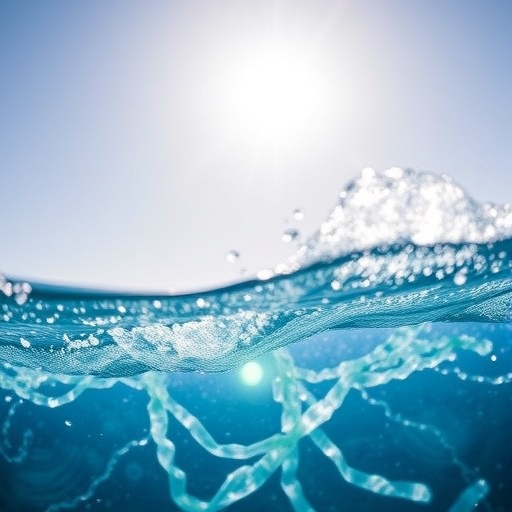A groundbreaking study recently conducted by researchers from the Chinese Research Academy of Environmental Sciences and Nanjing University of Information Science and Technology has unveiled a crucial mechanism through which synthetic textiles contribute to the pervasive problem of microplastic pollution in marine environments. The investigation centers on how sunlight, particularly ultraviolet radiation, acts upon polyethylene terephthalate (PET) fabrics submerged in coastal seawater, inducing photochemical transformations that fragment these materials into microscopic plastic fibers. This discovery marks a significant advance in understanding the environmental fate of textile-derived microplastics, shining a light on the intricate interplay between sunlight exposure, fabric pigmentation, and microfiber release.
The study involved a controlled laboratory simulation that replicated coastal oceanic conditions where colored PET fabrics were subjected to continuous UV-rich sunlight for a period reflecting approximately one year of natural exposure. The colored textiles included purple, green, yellow, and blue polyester, chosen for their diverse light absorption characteristics. Over 12 days—representative of this annual cycle—researchers meticulously quantified the release of microfibers, revealing a stark contrast between the fabric colors. The purple samples exhibited an alarming propensity to release thousands of microfibers, reaching quantities of nearly 47,400 fragments from only 0.1 grams of material, while the green, yellow, and blue counterparts generated significantly fewer particles.
This variation among colors is linked to the unique photochemical behavior of textile dyes and pigments. The purple dye absorbs more solar energy, catalyzing the generation of reactive oxygen species (ROS), notably hydroxyl radicals, in the surrounding seawater. These radicals are highly reactive intermediates that aggressively attack the polymer chains in PET fibers. By severing the chemical bonds in the polymer backbone, hydroxyl radicals expedite the breakdown of the fabric’s structural integrity. A detailed chemical quantification showed that purple PET fibers produced approximately 6.2 × 10⁻¹⁵ molar hydroxyl radicals, surpassing the levels observed in fabrics dyed green, blue, and yellow, thus accelerating the photodegradation process.
Advanced microscopic imaging corroborated the chemical analyses by revealing physical manifestations of photoinduced damage on the fabric surfaces. Samples exhibited extensive microfractures, surface roughening, and the separation of individual threads, all hallmark signs of material fatigue under environmental stressors. These physical degradations weaken fiber cohesion and promote fragmentation into microfibers, which are microscopic strands thinner than a human hair. As these fragments enter the marine milieu, they pose significant ecological risks.
Microfibers stand as one of the most ubiquitous forms of microplastic pollution in global oceans, deriving not only from fabrics but increasingly from household textiles that enter water systems via laundry effluents and improper waste management. Once introduced into marine ecosystems, these fibers are readily ingested by a variety of organisms, including plankton, bivalves, and fish. The ingestion of microfibers can lead to physical blockages, chemical toxicity, and biological disruptions within these organisms, raising concerns about bioaccumulation and potential human health impacts via seafood consumption.
The implications of the findings extend beyond environmental science into textile engineering and consumer products. The research team highlights the decisive role of textile coloration and dye chemistry in governing microfiber release rates. This insight challenges the conventional view that fabric color is merely an aesthetic consideration, urging the industry to rethink pigment selection and fabric treatment processes. By choosing dyes that absorb less UV energy or are less prone to generating reactive oxygen species, manufacturers could mitigate the generation of microplastics from synthetic textiles.
Moreover, the study underscores the broader concept of photoaging whereby prolonged exposure to sunlight fundamentally alters the chemical structure and physical properties of plastics. These processes are not limited to textiles but likely impact a wide array of plastic debris in marine environments, influencing degradation rates, particle sizes, and toxicity profiles over time. Understanding these photochemical dynamics is critical for constructing accurate models of plastic pollution dispersal and persistence.
The researchers also acknowledge that their laboratory simulation represents a simplified model of the complex marine environment. In situ factors such as biofouling, varying salinity and temperature, ocean currents, and the presence of other chemical pollutants will interact with sunlight-driven photochemical mechanisms in ways that are not yet fully understood. Future research aims to integrate these environmental variables to generate more comprehensive predictions of microfiber fate and transport.
This study opens new avenues for interdisciplinary collaboration among chemists, oceanographers, textile scientists, and environmental policy experts, aiming to design next-generation fabrics that balance functionality with environmental stewardship. The urgency of tackling microplastic pollution demands strategies that encompass source reduction, innovative material design, and robust wastewater treatment technologies.
In summary, this innovative investigation demonstrates that sunlight, by driving photochemical reactions on synthetic fibers, significantly accelerates the generation of microplastic microfibers in coastal seawater. The pivotal influence of fabric color and dye composition provides a new lens through which to view and address textile contributions to marine plastic pollution. These findings serve as a clarion call for industry stakeholders and environmental regulators alike to take proactive measures to mitigate the environmental footprint of synthetic textiles.
As the study delineates the mechanistic pathways of PET fiber degradation under solar irradiation in seawater, it also prompts a reevaluation of consumer behavior and textile lifecycle management. Consumers may need to be more aware of the environmental ramifications of fast fashion and synthetic fabric use, while manufacturers are urged to innovate towards sustainable materials and production methods. Ultimately, the intersection of photochemistry and environmental science illuminated by this research charts a path toward lessening the ecological burden of microplastics on ocean health.
Subject of Research: Not applicable
Article Title: Polyethylene terephthalate microfiber release from textiles in coastal seawater ecosystems under sunlight-driven photochemical transformation
News Publication Date: 5-Sep-2025
References:
Chen R, Zhao X, Wu X, Wang X, Wang J, et al. 2025. Polyethylene terephthalate microfiber release from textiles in coastal seawater ecosystems under sunlight-driven photochemical transformation. New Contaminants 1: e007.
Image Credits: Rouzheng Chen, Xiaoli Zhao, Xiaowei Wu, Xia Wang, Junyu Wang & Weigang Liang
Keywords: Photochemistry, Photochemical reactions, Reactive oxygen species, Seawater




